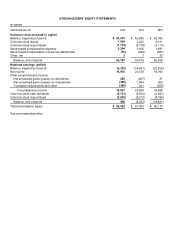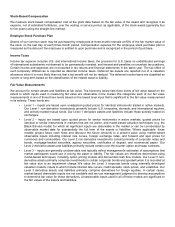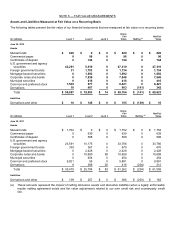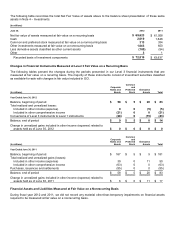Microsoft 2012 Annual Report Download - page 50
Download and view the complete annual report
Please find page 50 of the 2012 Microsoft annual report below. You can navigate through the pages in the report by either clicking on the pages listed below, or by using the keyword search tool below to find specific information within the annual report.Intangible Assets
All of our intangible assets are subject to amortization and are amortized using the straight-line method over their
estimated period of benefit, ranging from one to 15 years. We evaluate the recoverability of intangible assets periodically
by taking into account events or circumstances that may warrant revised estimates of useful lives or that indicate the
asset may be impaired.
Recent Accounting Guidance
Recently adopted accounting guidance
On July 1, 2011, we adopted guidance issued by the Financial Accounting Standards Board (“FASB”) on disclosure
requirements related to fair value measurements. The guidance requires the disclosure of roll-forward activities on
purchases, sales, issuances, and settlements of the assets and liabilities measured using significant unobservable inputs
(Level 3 fair value measurements). Adoption of this new guidance did not have a material impact on our financial
statements.
On January 1, 2012, we adopted guidance issued by the FASB on accounting and disclosure requirements related to fair
value measurements. The guidance limits the highest-and-best-use measure to nonfinancial assets, permits certain
financial assets and liabilities with offsetting positions in market or counterparty credit risks to be measured at a net basis,
and provides guidance on the applicability of premiums and discounts. Additionally, the guidance expands the disclosures
on Level 3 inputs by requiring quantitative disclosure of the unobservable inputs and assumptions, as well as description
of the valuation processes and the sensitivity of the fair value to changes in unobservable inputs. Adoption of this new
guidance did not have a material impact on our financial statements.
Recent accounting guidance not yet adopted
In December 2011, the FASB issued guidance enhancing disclosure requirements about the nature of an entity’s right to
offset and related arrangements associated with its financial instruments and derivative instruments. The new guidance
requires the disclosure of the gross amounts subject to rights of set-off, amounts offset in accordance with the accounting
standards followed, and the related net exposure. The new guidance will be effective for us beginning July 1, 2013. Other
than requiring additional disclosures, we do not anticipate material impacts on our financial statements upon adoption.
In September 2011, the FASB issued guidance on testing goodwill for impairment. The new guidance provides an entity
the option to first perform a qualitative assessment to determine whether it is more likely than not that the fair value of a
reporting unit is less than its carrying amount. If an entity determines that this is the case, it is required to perform the
currently prescribed two-step goodwill impairment test to identify potential goodwill impairment and measure the amount
of goodwill impairment loss to be recognized for that reporting unit (if any). If an entity determines that the fair value of a
reporting unit is greater than its carrying amount, the two-step goodwill impairment test is not required. The new guidance
will be effective for us beginning July 1, 2012.
In June 2011, the FASB issued guidance on presentation of comprehensive income. The new guidance eliminates the
current option to report other comprehensive income and its components in the statement of changes in stockholders’
equity. Instead, an entity will be required to present either a continuous statement of net income and other comprehensive
income or in two separate but consecutive statements. This portion of the guidance will be effective for us beginning
July 1, 2012 and will require financial statement presentation changes only. The new guidance also required entities to
present reclassification adjustments out of accumulated other comprehensive income by component in both the statement
in which net income is presented and the statement in which other comprehensive income is presented. However, in
December 2011, the FASB issued guidance which indefinitely defers the guidance related to the presentation of
reclassification adjustments.
























